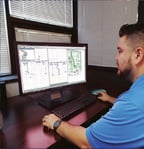By Jim Huddleston, Senior Consulting Engineer at Fauske & Associates (FAI)
Understanding and addressing electrical arc flash and shock hazards that may pose a significant risk to the safety of plant operators and electrical maintenance personnel is of great importance. The following is a list to help define and address this as well as to help ensure full compliance with all regulations and industry standards. 
Definition
According to Workplace Safety Awareness Council: "Simply put, an arc flash is a phenomenon where a flashover of electric current leaves its intended path and travels through the air from one conductor to another, or to ground. The results are often violent and when a human is in close proximity to the arc flash, serious injury and even death can occur. Arc flash can be caused by many things including: Dust, Dropping tools, Accidental touching, Condensation, Material failure, Corrosion, and Faulty Insulation.
Three factors determine the severity of an arc flash injury: Proximity of the worker to the hazard , Temperature and Time for the circuit to break. Because of the violent nature of an arc flash exposure, when an employee is injured, the injury can be very serious and can even result in death. It’s not uncommon for an injured employee to never regain their past quality of life. Extended medical care is often required, sometimes costing in excess of $1,000,000." Regulations
Regulations
OSHA 1910.269(l)(8) requires that employers estimate the Incident Heat Energies that their employees could be exposed to from Electrical Arcs and to provide properly rated protective clothing and other protective equipment for the protection of their employees against burns resulting from Electrical Arc Flash Hazards.
Standards
NFPA 70E Article 130.5 requires that Arc Flash Risk Assessments be performed for all facilities with Electrical Distribution Systems to determine the Arc Flash Hazard levels that exist (i.e. Incident Heat Energies, Arc Flash Boundaries) and the Personal Protective Equipment (PPE) that is required to be worn by your workers for their protection. The Arc Flash Risk Assessment for each facility is required to be updated whenever a major modification to the Electrical Distribution System takes place or at intervals not to exceed 5 years.
A Good Process (based on NFPA 70E-2015)
1. Hazard Identification
a. Collect Data→ Single-Line Diagrams, Electrical Equipment & Protective Device Data, Visual Inspection
b. Model the Electrical Distribution System→ Using Modeling Software (ETAP®, SKM or Equivalent)
c. Compute all Incident Energies→ Using the Model NFPA 70E and IEEE 1584 methodologies
d. Compute all Arc Flash Boundaries→ Using the Model and NFPA 70E and IEEE 1584 methodologies
2. Risk Assessment
a. Identify and analyze all electrical arc flash and shock hazards
b. Identify all tasks that are performed
c. Document the hazards associated with each task
d. Estimate the risk for each hazard and task
e. Determine the appropriate protective measures to adequately reduce the level of risk
3. Risk Control Strategies - Recommendations / Options
a. Elimination/Substitution→ Inherently Safe Design, Arc Resistant Electrical Equipment
b. Engineering Controls→ Protective Barriers, Faster Relays, Current Limiting Fuses, Neutral Resistors
c. Awareness→ Warning Signs and Labels
d. Administrative Controls→ Training, Procedures, Work Organization and Instruction
e. Personal Protective Equipment (PPE)→ Arc-rated clothing, Flash hood, Face shield, Insulating gloves
Other ideas? Thoughts? Share your ideas or if you have further questions please ask here or contact: AnnMarie Fauske, afauske@fauske.com, 630-887-5213. For more mechanical or electrical engineering/testing lab info, please see: http://www.fauske.com/engineering-testing-services/mechanical-electrical


